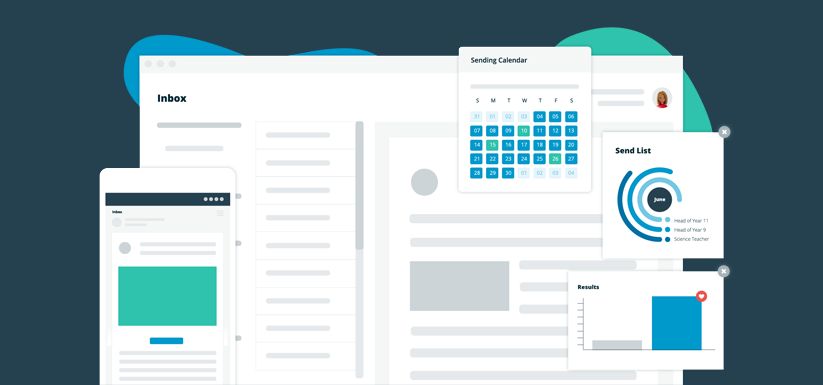A Beginner’s Guide to Blacklisting
A Beginner’s Guide to Blacklisting
Master inbox delivery and avoid getting your edu-marketing emails blocked with these eight questions and answers all about blacklisting.
Master inbox delivery and avoid getting your edu-marketing emails blocked with these eight questions and answers all about blacklisting.
While it may sound like some sort of priceless invite to a celebrity bash, a blacklist is more like the list of people ordered to keep out of the party. In essence, a blacklist is a digital collection of senders recognised for being a bit of a nuisance and sending out emails perceived as spam or scams (whether intentionally or accidentally). If you're on a blacklist, there's a very good chance your emails will be sent to the spam folder, if not totally blocked from ever entering school servers.
How does it work, exactly?
If you want to get technical, sent emails don't go straight from you to schools' inboxes - anything you send to them goes via their Internet Service Provider. As blacklists are publicly available, the ISP can see exactly which senders are on the list. Every time an email lands in the hands of the ISP, blacklists are automatically scanned to see if its sender is listed before the email is either accepted (and then scrutinised at a local level) or rejected completely.
These blacklists decide my email's fate - just like that?
Not quite - blacklists are just that: a list. It's the ISP who decides whether they're going to take the advice of the blacklist or not. If your email is only minorly problematic, or your sending reputation has so far been squeaky-clean, it might not be blocked at all, which explains why some recipients will receive your email when another (most likely with a different ISP) doesn’t. That said, they do go by the blacklists more often than not, so always assume the worst to be on the safe side.
Are there different types of blacklisting?
Yep - two types, to be exact.
IP blacklisting applies just your IP address - the unique number given to every computer, server, or other device when they connect to a network. If the spam emails keep coming from the same IP, it'll be added to a blacklist as an indication to junk or block further mail from the same IP address.
Then you have domain blacklisting, which applies to your entire domain (your online address) and all the IP addresses within it. Let's say you have five different servers (so, five IP addresses) all responsible for sending emails through your domain. If a lot of spam originating from the domain is detected, it'll be blacklisted. As the block isn't limited to just one IP address, you can't simply switch to a different server - your entire sending structure is affected.
If you’re talking about categories, there are three main ones: blacklists ran by anti-virus software and security companies, private blacklists held internally by companies such as Google or Microsoft, and public blacklists available to every ISP.
What exactly can get me blacklisted?
Blacklists are kept up-to-date (usually in real time) with data provided by ISPs. As mentioned, your IP or domain will be quickly blacklisted for repeatedly doing things deemed as spammy, unhygienic, or unusual. You can read our ultimate guide to avoiding the junk folder, which details the exact things you should avoid, but here's a brief rundown:
Spam:
You're probably familiar with the kinds of things that constitute a typical spam email - 'get rich quick' promises, phishing scams, and faux blackmailing attempts. But you can also wake the spam filters with things as simple as typos, large font sizes, and broken code. Given teachers also have the ability to manually mark you as spam, the relevancy and appeal of your content itself matter too. The more times your emails are flagged or manually marked as spam, the more likely you are to catch the attention of the blacklisting companies.
Unhygienic email practices:
If you're not regularly cleaning up your sending lists, or you're using dirty data from bought-in-bulk lists (which are usually full of old or fake addresses), you might quickly find yourself blacklisted. Mistyped, dormant, or non-existent email addresses will bounce, and many of these addresses will have been adopted as "spam traps" by ISPs who look out for senders with these addresses on their list. Oh, and make sure you provide an unsubscribe link - it's the law, and if you don't have one, anyone who wants to stop receiving your emails will have to mark you as spam instead.
Unusual behaviour:
Another reason to avoid bought data: your send list will grow dramatically overnight. While the thought may be tempting, it’s another sign to the ISP that you've bought your data and are perhaps sending to teachers who may not have legitimate interest in, or have consented to, receiving your emails. It's not just your send list size, either - if you suddenly increase the number of emails you send to your school list on a weekly or monthly basis, ISPs may think you're bothering those poor teachers or have been hacked.
So I can be blacklisted even though I'm not a serial spammer?
Unfortunately, yes, and it's common. It's impossible to guarantee that even your most perfectly crafted email will never get rejected (even by accident), and even the biggest and best companies slip up sometimes with a newsworthy email fail. One misspelled word won't get you instantly put on a blacklist forever, but if your emails regularly involved a handful of poor word choices, a little bit of broken code, or out-of-date send lists without you realising, then you could very well find your IP or domain on a few of the hundreds of blacklists out there.
How do I find out if I've been blacklisted?
A sudden drop in open rates is a typical sign you've been added to a big-name blacklist, but most of the smaller ones aren't as instantly noticeable in your results. Your server logs should be able to spot any problems and provide reasons for them, so monitoring your logs will usually give a good indication of any blacklisting. If you want to pinpoint the exact lists you're on, or you're just curious, then there are plenty of websites which scan hundreds of public blacklists to see if your IP address or domain is found on them.
Will I be listed forever?
In most cases for accidental offenders, the good news is no. You'll need to address the exact reason you've been blacklisted first - securing any compromised email addresses, cleaning your lists, and so forth - as getting caught still sending spam in the midst of a delisting request can get you permanently listed.
Once you've ironed out any issues, you'll need to go directly to the company you're blacklisted with to request your removal. The actual method of doing so differs from company to company, but you usually just need to fill in an online form.
This is blowing my mind… can someone help me?
Of course! Our dedicated email creation and testing processes, in-house sending servers, data management processes, and team of email experts give your emails the highest chance possible at landing safely in inboxes again and again.
Tags
Email Design
Email Marketing
HTML Email
Similar Articles


Our End-of-Term Education Marketing Results Review
At the end of another term helping businesses sell to schools, we're unveiling the incredible achievements from education marketing emails this term.


VIDEO: Selling to Schools Insights - Chapter 2 - Communicating with Schools
We analyse chapter 2 of The State of Selling to Schools 2023, discover how emails compare to social media and postal marketing, how often each is viewed and what leads to the most positive teacher responses.


Expert marketing to schools support and solutions
Expert marketing to schools solutions
Email Head Teachers, Teachers, and Staff Inboxes
Email teachers and staff inboxes
Sell More to UK and Global Schools and Colleges
Sell more to schools and colleges

































